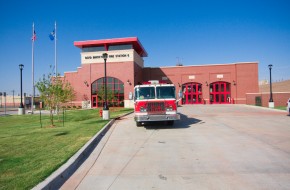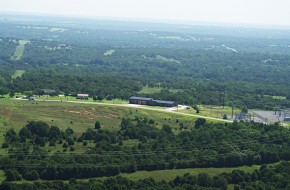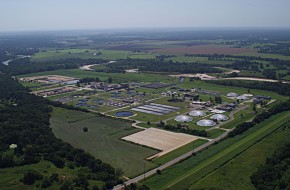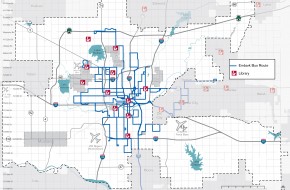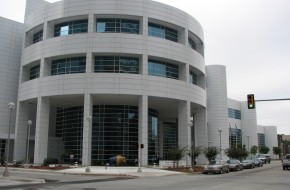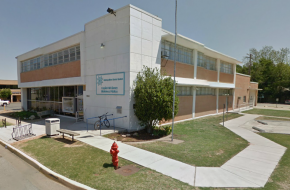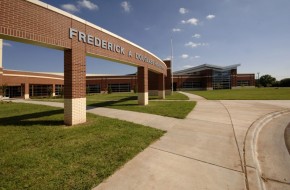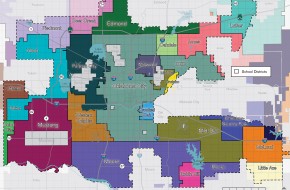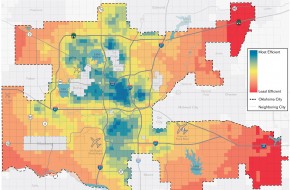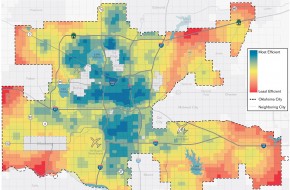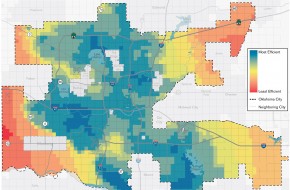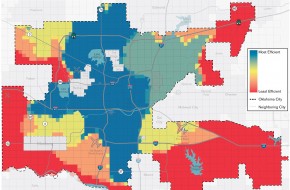Our Situation
Public Safety Services
Public safety agencies include the Fire Department, Police Department, and emergency management services.
Fire. The Oklahoma City Fire Department’s 1,000 employees provide a wide array of services that include fire prevention, fire suppression, rescue, code enforcement, arson investigation and public education. Increased travel times and call volume are taxing staff and equipment resources. To address these issues, the Fire Station Location Study (2006), a planning guide for the future needs for fire service in Oklahoma City, recommended relocating several existing fire stations and redeploying resources to improve response times. The report also proposed five new fire station locations. Covering the fire protection needs of Oklahoma City’s large areas requires maximum efficiency. In some cases, the Fire Department is being called on to address issues such as code enforcement, diverting resources from emergencies.
Specific fire protection challenges present themselves in the city’s various environments. In urban settings, abandoned structures pose a fire risk, since they can attract vandalism, often use materials that create hazards, and lack maintenance. In suburban areas, development design and building practices, such as shorter block length and residential sprinklers, can increase efficiency and quality of fire protection services. However, some developers do not employ these practices, citing added cost of infrastructure and equipment. Low water pressure at the urban/rural interface makes it more difficult to manage potential wildfires, posing a threat to property and public safety. Very low-density rural areas are extremely difficult to serve.
Police. The Oklahoma City Police Department’s force of over a thousand officers operates from a central police station with five substations. In addition to its primary law enforcement operations, the department is also responsible for emergency management and 911 programs. The department faces many of the same challenges as the Fire Department – a requirement to provide good service to a very large area and statutory limitations that limit operational funding to sales taxes. Dispersed development may require redistricting and additional resources.
Like the Fire Department, Police also sometimes receives misdirected complaints, like building code enforcement, which can be a distraction from actual duties.
Emergency Management. Oklahoma City provides a variety of protective services for emergency situations, including shelters, sirens and emergency response. Yet, providing these life-saving services can be challenging. Some bridges, especially in rural areas, are not suitable for emergency response vehicles. Consequently, vehicles are forced to take longer routes, increasing response times. Also, in a city where residential construction does not routinely include basements, many citizens do not have immediate access to an emergency shelter in dangerous weather conditions.
Utility Services
Utility services include solid waste and recycling, water distribution, and storm and sanitary sewer and treatment facilities.
Solid Waste and Recycling. Trash pickup and curbside recycling for Oklahoma City are provided by the City’s Solid Waste Management Division, but landfills are privately owned and operated. Landfill construction or expansion presents a variety of challenges to operations, costs, environmental justice, and other issues. At the same time, landfill operators generate revenue based on the weight of material disposed at the landfill, giving them no incentive to encourage customers to reduce the waste stream.
Partially as a result of this situation and the need for expanded educational initiatives discussed in greenokc, recycling rates are low throughout the city, both in number of participating households and pounds of recyclables collected. Without incentives or educational programs, recyclables and compostable materials instead find their way into landfills. Contracts and statutes that prohibit the City from providing solid waste and recycling service to businesses and multi-family housing further increase the amount of potential recyclables that are sent to landfills. Finally, the price of solid waste service is not related to either a customer’s usage, or the actual costs to provide the service. Therefore, customers again have no financial incentive to reduce waste.
A lack of data on recycling trends makes it difficult to address this problem and determine priorities for expanding recycling and extending the service life of existing and future landfills.
Water and Sewer. Oklahoma City’s drinking water supply uses surface water resources, and serves a per capita consumption of 180 gallons per day. Water and sewer distribution systems face the same challenges of population dispersion as public safety services. During the past thirty years, the utility service area has increased by 63% while population has increased by only 40%, increasing the per capita service cost.
Citizens tend to see water as an unlimited resource, but in our climate, it is becoming increasingly valuable. Yet, as with the solid waste stream, our incentives and educational programs to encourage conservation are relatively new. The City’s flat rates for water and sewer service encourage unlimited use and do not promote conservation.
In addition to use issues, the City’s water and sewer systems themselves have physical issues. In older parts of the city, aging infrastructure reduces level of service and raises the possibility of both interruptions and expensive repairs. And, as already noted in the discussion of fire protection, the water system is unable to maintain adequate and consistent pressure, especially at the outer reaches of the system. This situation is made worse by demands from neighboring municipalities and other large users. This increases the need for greater regional cooperation and shared use of resources.
Other issues include changes in regulatory standards and contested water rights. Changing federal and state standards for additional inspection, data collection, and new contaminant categories are raising the cost of treatment.
Other Public Services
City agencies and partner organizations offer a variety of individual services, many of which are addressed in other elements of planokc. Of specific concern here are library, education, and animal welfare facilities and services. Other key services include solid waste and recycling, water distribution, and storm and sanitary sewer and treatment facilities.
Library Services. The Metropolitan Library System serves approximately 600,000 people in 19 libraries in Oklahoma County. Over 500 library staff help provide materials lending, public education programs, and information access. The system is funded by an ad valorem property tax.
From a facility perspective, many library facilities are relatively isolated, lacking physical and social connections to nearby neighborhoods. With the exception of the Ronald J. Norick Downtown, developed as part of the MAPS program, traveling to most facilities requires an automobile, making the system less accessible to many of its major user groups.
Programmatically, libraries remain as important as ever to their customers and the region as a whole, but their roles continue to change with technology, changing demand for services, and an increase in their status as centers of community life and culture. However, the long planning timeline required for library facilities, sometimes as long as two decades, can make response to changes less nimble.
Education. Oklahoma City’s municipal limits encompass portions of 27 separate public school districts, the largest of which is the Oklahoma City Public School District. OKCPS serves 43,000 students in Central Oklahoma in a 135 square mile area with 55 elementary schools, 17 secondary schools, 4 special centers and 13 charter schools, and more than 4,600 staff members. While the school district’s policies and governance are independent of City government, the success of OKCPS and that of the entire community are highly dependent on each other.
The demographics of OKCPS have changed dramatically over the years. As of 2014, the student population is 3% Asian, 5% Native American, 20% Caucasian, 27% African-American, and 45% Hispanic. In addition, 13% of the district’s student population have disabilities and special needs, and over 31% do not speak English as their first language.
These changes, as well as overall patterns of achievement in the larger society, create significant educational challenges. Some parts of the city, such as south Oklahoma City, have seen substantial population growth and are experiencing overcrowding in neighborhood schools. A 2014 facility strategy recommended construction of two new elementary schools and one new middle school. On the other hand, some neighborhoods have lost population and may have unused capacity. However, the City has made enormous strides in facility and program development and modernization through the MAPS for Kids program. This effort, completed in 2012, benefited all of the districts in the city by investing $470 million in construction and rehabilitation of over 70 OKCPS schools, $52 million in technology projects, $9 million in bus fleet replacement, and $153 million in projects in the 22 districts outside of OKCPS.
OKCPS, like many urban school districts around the country, experiences serious disparities in achievement. The district’s overall student achievement index received a grade of “F” in the Oklahoma State Department of Education evaluation. planokc surveys and other research underline the importance of school district quality to housing choice and neighborhood location. In a city with multiple school districts, families with the means to do so choose to live in school districts with better performance reputations. Since these districts are largely suburban, this situation further concentrates lower income households, reduces income diversity in the central city, perpetuates income segregation, and exacerbates inefficient development patterns.
These concentrations create a vicious cycle of neighborhood effects. The relationship between household income and educational attainment is clear. Low attainment increases the potential for criminal activity, gang membership, and negative health outcomes. Classroom discipline problems erode the experience, increase homeschooling and online classroom practices, and reduce the social and community benefits of kids going to school together.
Some of the solutions frequently used to encourage higher achievers to stay in central city schools may create their own issues. Specialty schools, such as arts and science academies and magnet schools, pull the best students away from traditional middle and high schools, degrading the performance and other important indicators at those schools. High performing elementary schools that feed into average or low performing middle and high schools waste student potential and reverse advances made at earlier grade levels. Redistribution of students to attempt to equalize enrollment characteristics can lead to long transportation routes that increase costs and contribute to lower student performance.
High quality school districts are essential to many of our goals, including a healthy and productive population; compact, vital, and active neighborhoods and urban districts; and efficient and effective services.
Animal Welfare. The Animal Welfare Division of Oklahoma City provides temporary shelter and humane disposition of unwanted or lost animals. The division processes 33,000 animals per year and provides public education and other support for pet owners. The number of pets in Oklahoma City is expected to increase from around 400,000 in 2010 to over 500,000 in 2025.
Stray animals pose threats to people, property, and other animals, and are at risk from disease and physical harm. A lack of public knowledge about how to deal with strays increases these threats. Easily accessible information is needed to show people how to respond to stray and injured animals, and provide information about the possibilities and rewards of animal adoption and other animal-related situations.
Service Efficiency Analysis
The service cost analysis calculated the difficulty for City services to be provided to each area of the city. This calculation is organized around the six largest departments of the City and relies on the expertise of the department staff and information about what is on the ground today. The analysis compares how a given location might be more or less challenging to serve than another location.
Public Safety. The maps shown here illustrate the results of the service efficiency standards for fire and police services. Both departments must respond to citizen needs and emergencies at different locations from operational bases. While both fire and police have fixed facilities (fire stations and police substations), police add mobile operations through cruiser routes and pedestrian and bicycle-mounted police in high density urban sectors. Efficiency and effectiveness rely on three specific criteria:
- Density: the number of homes or business locations that are located in and can be served within a contained area.
- Contiguity: the proximity of a served area to existing development, to avoid gaps that add distance and travel time without adding service.
- Connectivity: the ease of travel within and area.
Water and Sewer. Water and sewer efficiency can be evaluated and analyzed in ways analogous to public safety services. This analysis calculates the difficulty of providing utility services to various areas. However, the criteria for analyzing utility service are different from those that apply to police and fire. Water service efficiency analysis is based on two major factors:
- The presence of existing water lines or the distances over which new lines would have to be constructed and maintained.
- Variations in ease of service due to features such elevation or distance to raw water sources.
Sanitary Sewer. Unlike water services, sanitary sewer efficiency is highly related to topography. Thus, the sewer efficiency analysis responds to two principles:
- Gravity flow is superior to pressurizing, requiring far lower capital and long-term maintenance cost.
- The capacity of each treatment plant to treat sewage and discharge effluent, influences the development potential and/or cost of all areas upstream from each plant.
The resulting sewer analysis sets priorities for areas that share a common low point for gravity powered flow of sewage, with adjustments for availability and potential for treatment capacity at that low point.
























 Download PDF
Download PDF